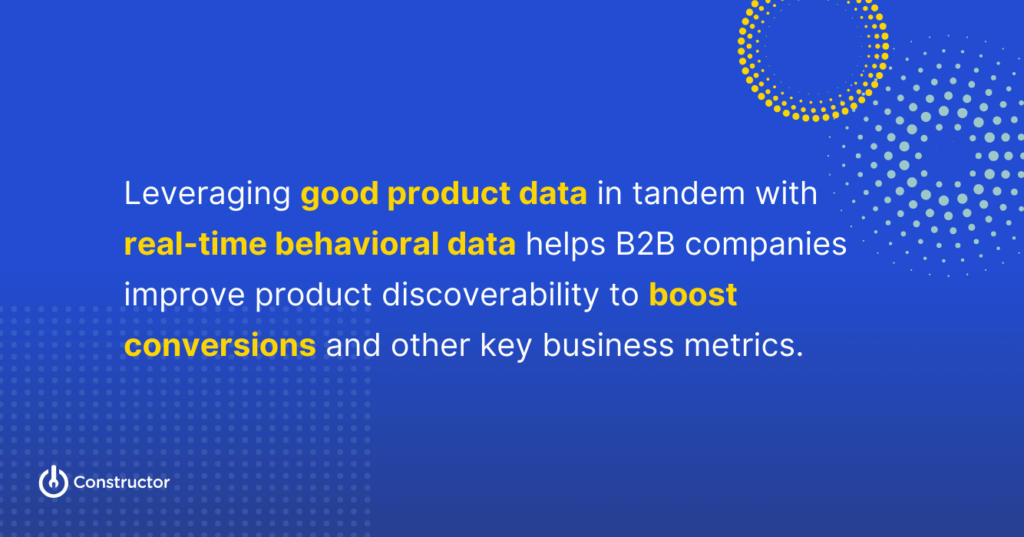Compared to their B2C counterparts, B2B ecommerce companies have unique challenges and opportunities when it comes to buyer acquisition and conversion.
Both types of companies operate in what is, indisputably, a digital age: where convenient, attractive, and frictionless buying experiences drive loyalty and engagement.
But whereas B2C brands often cater to shoppers prone to impulse buys, B2B distributors and manufacturers sell to a different type of buyer. That buyer isn’t necessarily someone who wants to be on-site but, rather, has to be — purchasing in response to a company mandate or looking to solve a clear problem. What’s more, the person tasked with researching B2B solutions isn’t always the same person who’ll make the end purchase.
For manufacturers and distributors today, seizing opportunities to create product discovery and overall ecommerce experiences that prioritize ease of use and efficiency is critical. Companies can harness technology to take advantage of five key B2B ecommerce strategies for an unfair competitive advantage this year.
1. Prioritize the Digital Customer Experience, Especially Online Search
B2B buyers are consumers, too. And their experiences making purchases in their personal lives color their outlook in the business world.
Unsurprisingly, a core part of a good customer experience is providing a great online one, especially as more digital natives exercise purchasing power. According to a recent Forrester report, “millennials dominate B2B’s digital buying decisions” and “frequently define the digital strategy of buying groups,” with “Gen Z and Millennial B2B buyers mak[ing] up more than two-thirds of senior-level digital purchasers.”
Data from BigCommerce’s Global B2B Buyer Behavior Report underscores the importance of hassle-free online product discovery, as buyers purchasing from manufacturers and distributors rely on salespeople later and less in their journeys. Consider this:
- 74% of B2B buyers use online platforms to purchase products.
- 65% use search engines as the main means of product discovery.
- When shopping online, poor search and navigation functionality is among the top 5 pain points of B2B buyers.
Plus, improving product search can generate quick wins for buyers and ecommerce teams alike. When leading marine products distributor Fisheries Supply de-platformed from their legacy search solution to an AI-native one, their ecommerce team recouped time in their day from no longer having to set up search synonyms, manual workarounds, and redirects for common search queries. Because popular search queries return the right items, the switch redefined Fisheries Supply’s buyer experience and improved their bottom line: increasing revenue per user (RPV) by 15%.
2. Employ Personalization vs a One-Size-Fits-All Approach
Digital strategies should be built around the customer and their buying experience, from marketing to product discovery to purchasing to shipping. Achieving this customer-first mentality with agile, flexible digital technology not only provides you with the right tools, but also allows you to pivot and adapt when needed.
And what is personalization if not the ultimate in customer centricity?
Encouragingly, as cost and technical barriers have dropped in recent years, personalization technology has become much more democratized. So, delivering great online personalization isn’t just aspirational nor a B2C-only feat.
Product search and discovery solutions make user-level personalization possible via large language models (LLMs), transformers (the “T” in ChatGPT), and first-party behavioral data, customizing every step of the buyer journey — search results, landing pages, product recommendations, and more.
Leading B2B ecommerce companies apply personalization to:
- Display personalized and dynamic pricing based on criteria including orderer vs buyer permissions, customer relationship, market demand, geography, or industry.
- Factor geographical regulations and restrictions into product rankings. For example, buyers in Georgia and California may not be able to purchase the same metals or chemicals from a supplier due to regional regulations. An AI-based personalization engine knows this and can show the right products to the right buyer.
- Improve the ease of reordering and replenishing, highlighting product recommendations that reflect the buyer’s unique history.
- Do much more, enabling companies to increase client loyalty, reduce order abandonment rates, and hit key business metrics despite having large, complex catalogs.
The right product search and discovery platform allows B2B buyers to benefit from a helpful, expedited, and frictionless purchasing experience — even across multiple sessions.
3. Access and Act on Real-Time Data
For B2B use cases, traditional keyword search engines often fall short of expectations. They’re usually unable to recognize buyer intent nor understand measurements, product identification numbers, and partial SKUs in popular queries. (To work around this, B2B companies bolt AI onto these older, general-purpose technologies, inadvertently creating a “Frankensearch” monster in the process.)
Couple this with the fact that B2B distributors often manage incomplete product data from disparate sources (manufacturers, wholesalers, online marketplaces, etc.), and you’ll see why it’s virtually impossible to rank products attractively in real-time — without the use of AI
Leveraging good product data (more on how to solve for this later!) in tandem with real-time behavioral data can help B2B ecommerce companies match the right buyer to the right item at the right time. This not only provides an accurate barometer of intent and basis for personalization, but also boosts conversions and other key business metrics.

And it comes right at a time when 63% of business buyers say most customer experiences fall short of what they know is possible.
4. Tap into AI-Native Solutions
Creating B2B product discovery experiences that are personalized to the buyer and optimized for key business metrics is often onerous, error-prone, and simply not scalable with a manual, rules-based approach.
Thanks to AI and machine learning, B2B distributors and manufacturers can automatically detect patterns and anomalies in buyer experiences, personalize interactions across touchpoints, and determine next best actions across the buyer journey to yield unmatched ROI.
In addition to this, AI-native solutions also have the ability to:
- Bridge the gaps in product catalogs. Bad or missing product catalog data results in leaked revenue and poor item searchability. AI-native Attribute Enrichment leverages deep learning and machine vision to rapidly classify and categorize items, assigning them attributes to fill in the gaps in product catalogs. More complete, better product information drives purchases as buyers can more easily discover the products they’re looking for within complex, extensive catalogs.
- Improve and automate other aspects of catalog management to enhance organizational and operational efficiencies.
- Improve supplier relations in B2B distribution. An AI-based solution can help B2B distributors clean up and organize product data from hundreds of suppliers, creating a “single source of truth.” By rapidly ingesting and analyzing millions of data points, it aids in identifying actionable trends, errors, and inconsistencies; collecting and cleansing product data; enriching product information automatically; and even translating product content.
5. Take Advantage of Composable Commerce
Another key B2B ecommerce strategy is leveraging composable commerce. This runs counter to traditional, monolithic ecommerce platforms. They purport to handle everything and by doing so, often fail to address business needs thoroughly.
B2B manufacturers and distributors can turn their ecommerce tech stacks into a competitive advantage by adopting a composable approach.
Composable commerce refers to an ecommerce tech stack built of interchangeable, best-of-breed building blocks called microservices. Sharing data between each other via APIs, these software components are easy to combine, update, and swap out to meet specific business requirements.
The MACH (Microservices-based, API-first, Cloud-Native SaaS, and Headless) architecture inherent in composable commerce results in increased agility and speed-to-innovation, improved customer experiences, better insights and decision-making, and enhanced collaboration and partnerships.
B2B Commerce Doesn’t Have to Be Complicated
B2B distributors and manufacturers face complexities in their pricing structures, product catalogs, order management and fulfillment, shipping and logistics, and more. But for their buyers, commerce doesn’t have to — and shouldn’t — be complex.
“B2B buyers want and deserve frictionless experiences that support their internal workflows and make their lives easier,” said Nate Roy, Director of Brand and Content at Constructor in a recent Commercetools webinar. “That’s really what it’s all about: serving the customer. …Commerce doesn’t have to be complicated.”
The time is now to tap into these B2B ecommerce strategies to create experiences that satisfy and convert buyers and secure an unfair competitive advantage this year.


